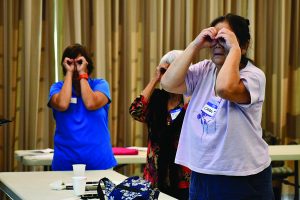Human beings use five ways to take in data: sight, touch, smell, taste and sound. From the time we are born, we prefer to take in data first by what we see, then hear and finally through touch. Vision, our primary source for processing new information, is controlled by an area in the back of our brain called the occipital lobe. Dementia attacks and damages the occipital lobe resulting in skewed vision, poor depth perception and diminished peripheral vision. Peripheral vision loss is a normal part of aging but with dementia, it worsens to where sight becomes “binocular” and, in the later stages, “monocular.”
 Teepa Snow, a dementia expert, occupational therapist and Positive Approach™ to Care founder, suggests we can experience how limited a view this is by forming makeshift binoculars. Move both your hands up to your eyes, then loosely circle your fingers around your eyes to make two binocular-like tunnels. Take a look around you — notice that you need to move your entire head in order to look to up, down and to your sides. How might this hinder a person’s abilities?
Teepa Snow, a dementia expert, occupational therapist and Positive Approach™ to Care founder, suggests we can experience how limited a view this is by forming makeshift binoculars. Move both your hands up to your eyes, then loosely circle your fingers around your eyes to make two binocular-like tunnels. Take a look around you — notice that you need to move your entire head in order to look to up, down and to your sides. How might this hinder a person’s abilities?
Now hold your arms straight out in front of you about shoulder width apart and look only down that one “tunnel.” A person living with dementia (PLWD) in the later stages of vision loss has a field of vision of about 12 inches in diameter in all directions. This means they cannot see something unless it is directly in front of them at just about eye level — monocular vision.
This shrinking field of peripheral vision presents many challenges besides making a person easily startled when approached from the rear, tripping over obstacles in their path or misjudging how far away an object is when they reach for it. For example, road safety would be a major concern for the PLWD who has binocular vision.
HELPFUL CARE PARTNER TIPS
- Be mindful of your loved one’s safety and in-dependence — think five steps ahead to remove obstacles in walking paths.
- Always approach the PLWD from the front so they can see you coming and to avoid negative reactions like anger, fear and/or surprise.
- Pair visual cues with verbal cues when asking your PLWD to do something — show them how.
- Find support groups in your area.
——————-
PAC HUI HAWAII
808-469-5330 | PAChawaii4@gmail.com
www.PacHuiHawaii.com
PAC HUI HAWAII is a caregiver training organization utilizing the Positive Approach™ to Care philosophy developed by Teepa Snow. To know more of the organization and current workshops and other events, please visit us online.


Leave a Reply